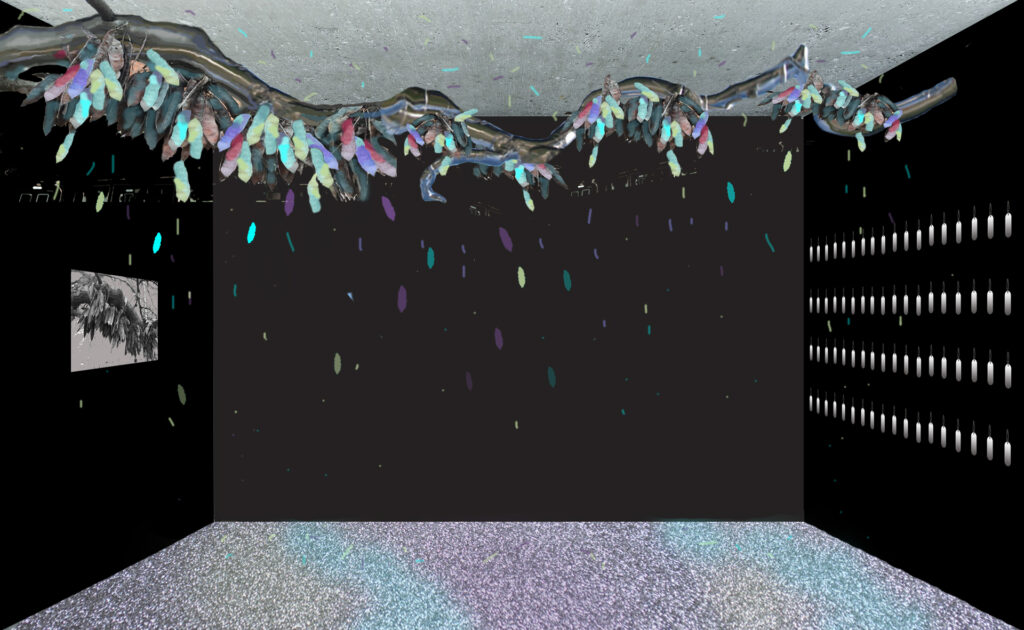
“Botanica Absentia” by Margaret Keller (Credit: Courtesy of Margaret Keller)
The room is a velvety, lightless black, except at the center, where light refracts through dichroic glass pendants and makes rainbows on the holographic floor. They are meant to cheer us up.
This is Margaret Keller’s Botanica Absentia installation at the Contemporary Art Museum St. Louis, and we have just stepped seventy years into the future. We are on a space station, because humans have vanished from Earth, as have many animals and trees. One wall of the station is covered by stainless steel “dog tags” that say Memento Mori, then name an extinct tree’s species. I stand closest to the tag for the Blood Tree, but they are not all so exotic, or so aptly named. There are many friendly and familiar trees on the list Keller used to select her victims: the American elm, the chestnut, the wild apple, the giant sequoia, the beloved Fraser fir, endangered because despite (or because of) all those Christmas tree farms, it is unable to reproduce on its own in the wild.
Narrow and shiny, the tags hang in neat rows, a commemoration that also feels anonymous, the way a military cemetery does, because the individual is one of so many.
“One in every five tree species are in danger,” Keller tells the handful of us who have plowed through the rain to take her drawing class. “That’s twenty percent.”
Eyes downcast, we try to focus on the rainbow. “It’s supposed to add just a tiny bit of hope,” says Keller—but for me, that would require a real rainbow, made by sunshine and shining through a window. This room is beautiful but grim. The giant tree branch from which the glass “seed pods” dangle has been stripped and silvered, denatured. Each pendant is transparent, but also a mirror; it is impossible to escape yourself, your role in creation’s end.
(Though uncertain about a Creator, I still use the word “creation.” Energy streams through the world and brings it to life, the way a work of art comes to life in the hands of a genius. As the Jesuit poet Gerard Manley Hopkins wrote, “there lives the dearest freshness deep down things,” and God knows I had nothing to do with it.)
We talk about burying our heads in the sand; about guilt, shock, and rage. “In my native country, Romania, we are cutting the forest and using it for furniture,” one woman says, spitting the last word. “I don’t know what to do about it.” A young girl has come to class, and she blurts, “I’m honestly concerned about what my future is going to be with all the plastic in the ocean.”
Gently, Keller ushers us into the next room, tells us about ways we can make a difference, and hands us art supplies. She has found paper that is shiny black until you scratch an image onto its surface and a rainbow of holographic color shows through.
The mood brightens. Purposeful now, we get to work, finding reference images on our phones, gathering up metallic leaves Keller has supplied. “Do you know what kind of tree this is?” people ask, showing the screen of their phone. Wanting, more than ever, to know.
The woman across from me focuses on just a small area of a rough old tree trunk, carving colors out of the bark. Another woman draws a rainfall of shapes.
“Seed pods?” I ask.
“Tears.”
The girl sticks down a blanket of silver leaves, letting them emerge from a many-colored tangle of roots. I think of the way trees communicate underground, how they share nutrients to heal and save each other.
“In Thailand, they gather seeds from whatever they eat and throw them on empty ground,” someone says quietly.
We are too arrogant to bother, I think to myself. As a nation, we are not even admitting the danger.
Looking down, I find I have drawn a gnarled old apple tree. This is no surprise; I have always loved them. I curve its branches so it is climbable and sketch in a hollow big enough to shelter an owl. Then I scribble in apple after apple, letting the fruit multiply. The paper shows through in a range of colors, which is fine with me: This is my tree, I think, cocky and pleased. I can make it bear hundreds of improbable apple species at once if I like.
Deciding that my tree is bonsai scale, I carefully draw a museum display case around it, preserving it for the future. The minute I add the glass top, all the life drains away. The case feels claustrophobic and unnatural. Quickly, I sketch in a bird in flight, only to realize that it will smash into the glass cabinet. A weird panic shivers through me: He is trapped in there. And so are we.
Holding the paper at arm’s length, I tilt my head and take a few deep breaths. Then, without thinking, I draw an apple plummeting from the tree.
Falling, all over again.
